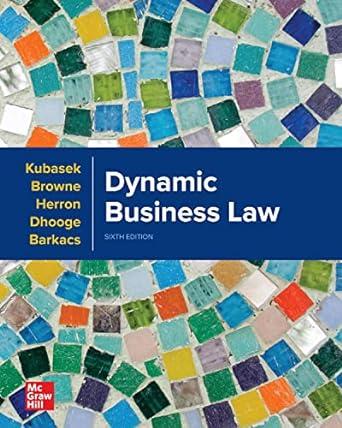Question
The first part of the course we discuss methods of legal dispute settlement (i.e. how the law aims to resolve disputes/ how we use legal
The first part of the course we discuss methods of legal dispute settlement (i.e. how the law aims to resolve disputes/ how we use legal processes to settle or end disputes). In W3 and W4 we examine "alternatives" to the formal dispute resolution processes offered by the courts. We specifically focus on the potential value of ADR (in "private law" matters) and Restorative Justice (in "criminal law" matters). In her article from the course text (p. 154- 161) Daly explains and evaluates the potential of restorative justice (RJ) as an alternative to criminal justice (CJ). She identifies six potential "limits" of the processes and goals of RJ and asks the reader to consider its value when comparted to what CJ can offer. The documentary A Different Kind of Justice (Brightspace) tells one story of restorative justice and offers us a practical look at its possibilities and (maybe its) limits. Drawing explicitly on these two sources, address the following question(s): How does the documentary support or challenge the limits of RJ described by Daly? Based on the documentary and article, should Canada expand its RJ approaches to dispute settlement in criminal matters? Why or why not? Did the article or documentary make you think differently about how we address/resolve criminal law disputes? Your reflection/response must do the following:
1) Demonstrate a basic understanding of the core elements of Daly's article; specifically show you understand the "limits" to RJ she identifies.
2) Demonstrate that you listened to and understood the documentary.
3) Be able to critically connect the documentary as a practical application of RJ principles to the points made by Daly in her article.
4) Evaluate the strengths and weakness of the RJ approach and link to the Canadian context.
5) Address whether your position on RJ was challenged/affirmed based on what you heard and read Your response should also:
a) Be organized around a main idea or "thesis" statement b) Refer directly to the course sources using consistent and clear (intext) citations c) Demonstrate "engagement" with the sources (go beyond basic summary) d) Demonstrate care in the preparation and presentation of the response.
Step by Step Solution
3.41 Rating (151 Votes )
There are 3 Steps involved in it
Step: 1
Answer In her article Daly examines the potential of restorative justice RJ as an alternative to criminal justice CJ and highlights six potential limi...
Get Instant Access to Expert-Tailored Solutions
See step-by-step solutions with expert insights and AI powered tools for academic success
Step: 2

Step: 3

Ace Your Homework with AI
Get the answers you need in no time with our AI-driven, step-by-step assistance
Get Started


